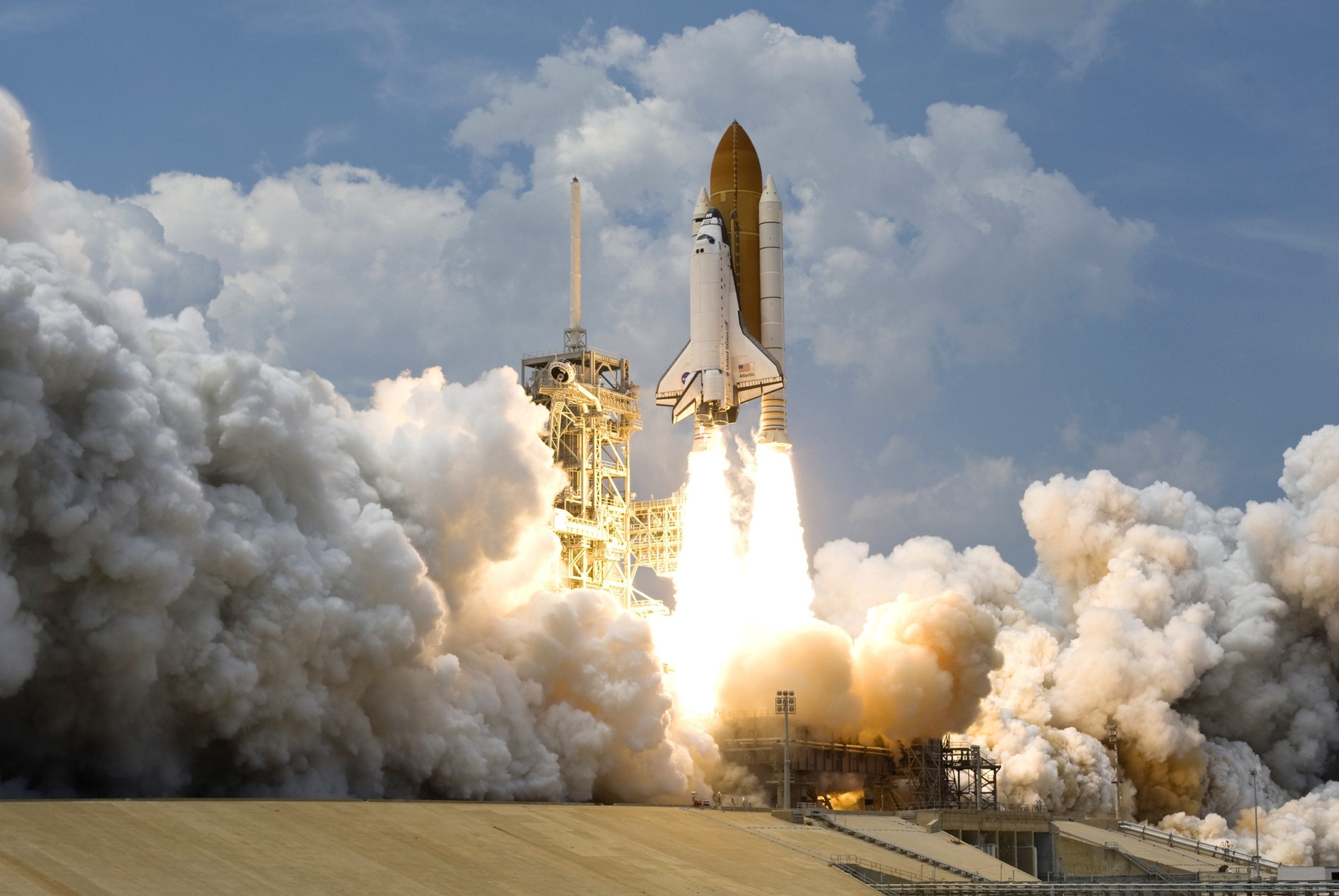
How does a rocket engine work? Rocket engines work because of Newton’s third law of motion.
Newton’s third law of motion states “to every action there is always opposed an equal reaction; or, the mutual actions of two bodies upon each other are always equal, and directed to contrary parts.” Or, in other words, for every action, there is an equal and opposite reaction. An example of this is when you swim. You push the water backward with your hand. The force generated in the backward direction produces an equal force in the forward direction, moving you forward.
A rocket engine contains a fuel source. When the fuel source is ignited, it produces gas, which is released through the hole at the end of the rocket. Before I researched this question, I believed that a rocket takes off and flies because the gas forced out of the engine pushes on the ground or the air and forces the rocket forwards. This is not correct. The rocket is pushed by the gas alone.
Rocket fuel has to be mixed with oxygen to burn. When the fuel is ignited, it produces a gas that rapidly expands and pushes on the rocket in every direction. It pushes left, right, up, down, and everywhere. When it pushes to the left, it pushes to the right with equal force and the rocket doesn’t move in either direction. When it pushes to the front, it pushes to the rear with equal force and the rocket doesn’t move in either direction. When the gas pushes up, it also pushes down, but the bottom of the engine has a hole, so the gas is released. There is no counter push to the upward force, so the rocket moves up. The rocket pushes itself by pushing off the gas it releases. This is obviously why rockets can move in space when there is nothing to push against. The same thing can be seen with a gun. When you fire a gun, the bullet escapes and the expanding gases can only escape out of the barrel. They have equally opposing forces in every direction except for backwards, so the gun recoils.
There are two types of rocket fuel: solid state and liquid. They both have advantages and disadvantages. A solid fuel rocket is basically like a firework. The fuel burns with the same intensity and there is no way of adjusting it. The rocket will push itself forward until the fuel has burned out. Solid fuel rockets are easy to store, and they are compact. They are simple and they can produce more thrust than liquid fuel. However, solid fuel rockets cannot be stopped once they have started. Liquid fuel is more efficient and the rate of flow of fuel can be controlled, providing different rates of thrust. However, the fuel is extremely toxic and has to be stored at very low temperatures. They are more expensive to produce because they need valves, seals, pumps, and other equipment that solid fuel doesn’t need. Frequently, solid fuel is used for the initial launch and liquid fuel is used for later stages.
So, how does a rocket engine work? Before liftoff, the rocket will be mostly fuel. The problem with a rocket is you need tremendous thrust to escape Earth’s gravity. The escape velocity for Earth is 11.2 km/second. To get that much thrust, a lot of fuel is required. The problem is, the more fuel the rocket carries, the heavier it is, which means it needs more fuel. 96% of a solid fuel rocket and 90% of a liquid fuel rocket are fuel. That leaves less than 10% for everything else, which is why it is so expensive to get anything into space.
At liftoff, the fuel is ignited by a plasma ignitor. The fuel starts to burn, releasing gas and the engine reaches full power in 7 seconds. There are usually another two solid fuel boosters that ignite at this point and the thrust is enough to lift the weight of the rocket. The rocket rises for about 12 seconds and then turns onto its trajectory. The two solid rockets will be jettisoned about 220 seconds into the flight. If the flight is going to a higher orbit, there will be more burns to get it higher.
The future of rocket engines lies in finding greener fuels. Rockets produce a lot of pollution, although they don’t fly very often. There are ideas for alternative fuels, but they all don’t provide enough lift to get a rocket into space. They are all designed to provide thrust to a rocket that is already in space. Three of those ideas are nuclear fission, ion drives, and laser power. All of these would provide a tiny thrust, but it is a thrust that would keep building if it was left on for long enough. A ship could, theoretically, constantly accelerate.
So, how does a rocket engine work? By providing a force forwards that is not countered by an equal force backwards, which pushes the rocket. And this is what I learned today.
Sources:
https://dewwool.com/newtons-third-law-examples/
https://www.sciencelearn.org.nz/resources/390-rockets-and-thrust
https://science.howstuffworks.com/rocket.htm
https://en.wikipedia.org/wiki/Rocket_propellant
https://www.grc.nasa.gov/www/k-12/rocket/TRCRocket/rocket_principles.html
https://www.uu.edu/dept/physics/scienceguys/2002Sept.cfm
https://www.nasa.gov/mission_pages/station/expeditions/expedition30/tryanny.html
https://www.science.gov/topicpages/i/ignition+rocket+engine
https://www.explainthatstuff.com/spacerockets.html
https://www.esa.int/About_Us/ESOC/Liftoff
https://theconversation.com/a-new-era-of-spaceflight-promising-advances-in-rocket-propulsion-160396


[…] Kármán Line, the atmosphere is too thin to provide enough lift for a conventional plane to fly. A rocket can fly because it only relies on the thrust of its engine. A plane needs the lift of the air to fly, and […]